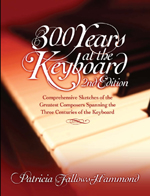Throughout history there have been countless classical keyboard composers but most people will agree that there are only a handful of really great composers who stood out and influenced most other composers.
If you are a student of the keyboard I am sure you will want to get to know these great composers so you can decide which ones deserve your further attention and time.
We have produced a 312 page book that covers 17 of the greatest classical
keyboard composers in history. Click on the book at the left to see detail
information on the book.
Composer example....To see a sample of what is done for each composer click on a picture of the composer picture in left column.
The History and Evolution of the Piano
The word “piano” is the English term for the familiar keyboard instrument whose full name is “pianoforte” (from the Italian, soft-loud). It has basically evolved from the dulcimer, clavichord, and harpsichord, instruments in use in the 14th and 15th Centuries. In its present form, it is built on an iron frame and is either a grand (horizontal) or an upright. Its standard compass is 7-1/3 octaves (88 keys), but some models by Bosendorfer have 8 octaves.
The dulcimer, a closed shallow box over which were stretched wires to be struck with two wooden hammers, was a forerunner of the clavichord of the 14th Century. The spinet, virginal, clavecin, and gravicembalo were predecessors of the harpsichord of the 15th Century. As keyboard music assumed importance in the 16th and 17th Centuries, its chief instruments became refined versions of the clavichord and harpsichord.
The idea for the piano was inspired by the action of the clavichord and the substantial sound projection of the harpsichord. The conception of the clavichord’s hammer action and the level of volume possible with the harpsichord were carried over into an instrument created by the Italian, Cristofori (1655-1731). First exhibited in Florence in 1709, Cristofori’s instrument was called gravicembalo col piano e forte, a harpsichord with soft and loud tone. (His first surviving piano dates from 1720 and can be seen in New York’s Metropolitan Museum.) Cristofor’s ideas were then used by a German organ builder, Gottfried Silberman (1683-1753) who incorporated further improvements in the new instrument.
During the last quarter of the 18th Century and the first part of the 19th, piano construction developed rapidly in Austria, England (John Broadwood and Sons), France (Pleyel, Érard), and later in America (Chickering, Steinway). The most acceptable piano which evolved after Silberman’s was made by his disciple, Stein. When factories moved from Augsberg to Vienna, the Stein pianos incorporated a further improvement in mechanism called the Viennese action. It was the Stein Viennese action piano which Mozart adopted in 1777. He also knew, played, and owned a fortepiano (c. 1780) by Anton Walter which some contemporary musicologists feel should be used in replica to reproduce the piano music of Haydn, Mozart and early Beethoven. Mozart’s endorsement of the Stein piano and fortepiano gave other keyboard instruments a less important role except for special effects and historical interest. The evolving instrument was eventually called simply a piano, or a grand piano because of its increased length and breadth.
The years between 1709 when Cristofori exhibited the first piano, and 1777 when Mozart adopted it, determined the future of piano playing and composing. Bach was acquainted with the instrument but preferred the harpsichord and clavichord. Haydn was not primarily a keyboard artist-nevertheless, he was aware of the extensive developments of the piano during his lifetime when he composed his later works. Mozart, a superb performer and daring innovator, adopted the piano when he was twenty-one and used it exclusively in his concerts. He composed the majority of his keyboard works with the advancements and advantages of the piano in mind.
Beethoven in turn discarded the light action piano employed by Mozart for the weightier English Broadwood, but he did not live to see the keyboard range enlarged to its current maximum of 7-1/3 octaves. From Beethoven’s time until the present, demands of composers and resourcefulness of manufacturers have combined to produce increasingly satisfying pianos, remarkable for sonority and tonal contrast......
Lots more…….More about the publication, including reviews by major magazines and sample pages from the book can be found by clicking here:
![]()
Composer example....To see a sample of what is done for each composer click here:
![]()



